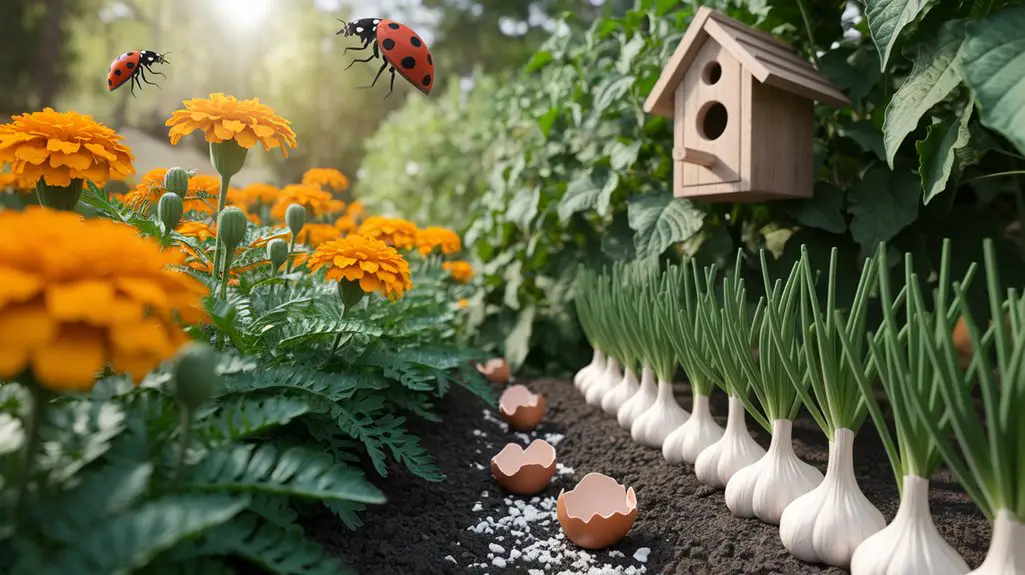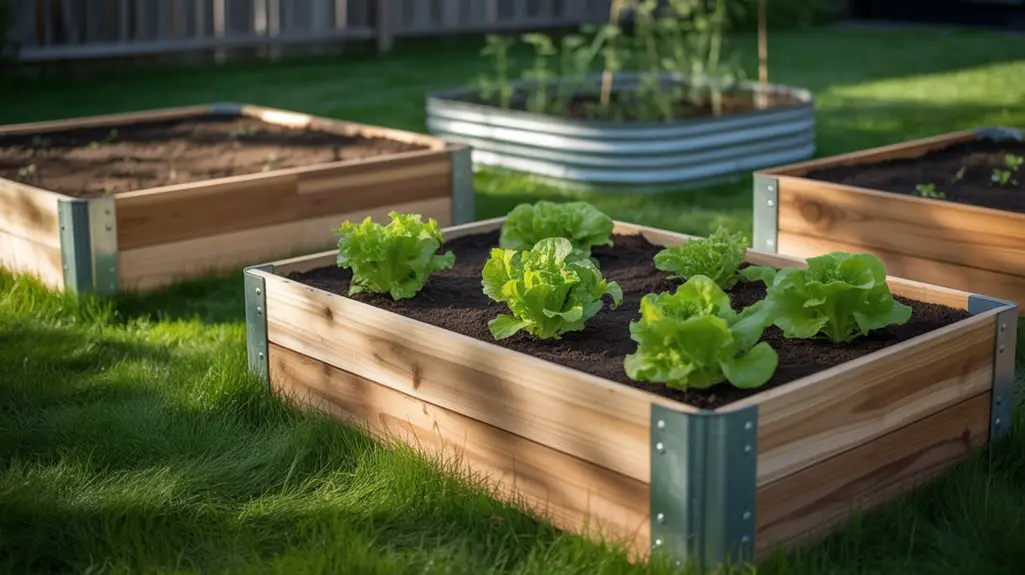Did you know the average gardener uses synthetic pesticides more than 10 times per growing season, often unnecessarily? You can dramatically reduce pest damage to your plants without introducing harmful chemicals into your garden ecosystem. Natural pest control methods not only protect your produce and flowers, but also maintain the delicate balance of beneficial insects and soil microorganisms that contribute to your garden’s long-term health. These ten effective strategies will transform your approach to garden protection.
Companion Planting: Nature’s Pest Deterrent Strategy
When gardeners embrace companion planting, they tap into one of nature’s most elegant defense systems against pests. You’ll find that strategic plant pairings create natural barriers that confuse, repel, and deter unwanted insects while attracting beneficial predators.
Consider planting aromatic herbs like basil near tomatoes to repel hornworms, or marigolds throughout your garden to discourage nematodes. Nasturtiums serve as trap crops, luring aphids away from your vegetables, while dill and fennel attract predatory wasps that feed on caterpillars.
You’ll achieve the best results by researching specific plant affinities. Some plants release biochemicals that mask the scent signatures pests use to locate their preferred hosts. Implementing natural pest control strategies considerably reduces pest pressure without chemical interventions, preserving your garden’s ecological balance.
DIY Organic Sprays for Common Garden Pests

While chemical pesticides often promise quick results, homemade organic sprays provide effective alternatives that protect both your plants and beneficial insects.
Create a potent garlic spray by blending 4-5 cloves with 2 cups water, straining, and adding a teaspoon of mild soap. For fungal issues, mix one tablespoon of baking soda with a quart of water and a few drops of dish soap.
Neem oil solution (2 teaspoons oil, 1 teaspoon soap, and 1 quart water) works against aphids, mites, and whiteflies. For slugs and soft-bodied pests, apply diatomaceous earth around susceptible plants.
In addition to these methods, incorporating eco-friendly pest control solutions can further enhance your garden’s resilience against pests.
Remember to spray in early morning or evening to prevent leaf burn, and reapply after rain. Always test new sprays on a small leaf area first to guarantee plant tolerance.
Beneficial Insects: Recruiting Nature’s Pest Control Army

Instead of battling garden pests with sprays alone, you’ll find greater success through encouraging nature’s own pest control system. Beneficial insects work tirelessly to keep pest populations in check, often more effectively than any product you can apply. Additionally, using effective natural insecticides can complement the efforts of these beneficial insects, creating a robust defense against pests.
| Beneficial Insect | Target Pest | How to Attract |
|---|---|---|
| Ladybugs | Aphids, mites | Plant dill, fennel, yarrow |
| Lacewings | Aphids, caterpillars | Provide shallow water dishes |
| Parasitic wasps | Caterpillars, beetles | Grow herbs with small flowers |
| Praying mantis | Most garden pests | Leave undisturbed areas nearby |
| Ground beetles | Slugs, cutworms | Install flat stones for shelter |
Create diversity in your garden with companion planting strategies that attract these allies. You’ll need fewer interventions when your garden ecosystem becomes self-regulating, saving time while improving yields naturally.
Strategic Garden Layout to Minimize Pest Problems
The layout of your garden serves as your first line of defense against persistent pest invasions.
Implement companion planting by pairing vulnerable crops with pest-repelling plants like marigolds, nasturtiums, and herbs such as basil and mint. Create physical barriers by arranging taller plants to shield more susceptible varieties.
Rotate crops annually to disrupt pest life cycles—insects that target specific plant families won’t find hosts in the same location year after year.
Incorporate diverse plant families to prevent pest population explosions, as monocultures become magnets for specialized pests.
Establish pollinator-friendly zones with flowering plants that attract beneficial insects.
Leave adequate spacing between plants to improve air circulation, reducing fungal diseases that weaken plants and make them susceptible to secondary pest attacks. Additionally, natural pest management strategies can enhance the effectiveness of your garden layout by integrating various organic techniques.
Homemade Traps to Capture Unwanted Garden Visitors
Creating homemade traps offers an economical and non-toxic approach to managing common garden pests without resorting to chemical interventions.
For slugs and snails, place shallow dishes of beer in problem areas—they’re attracted to the yeast and will drown in the liquid. Construct sticky traps using bright yellow cardboard coated with petroleum jelly to capture aphids, whiteflies, and fungus gnats.
For larger pests, build a simple bucket trap by placing food scraps at the bottom of a container with sloped sides that prevent escape. Japanese beetles respond well to pheromone traps, while fruit flies can’t resist apple cider vinegar with a drop of dish soap in a jar with a perforated lid.
Additionally, using non-toxic pest control methods not only protects your plants but also helps maintain a healthy ecosystem in your garden.
Position your traps strategically near affected plants but away from beneficial insect habitats to maximize effectiveness.
Soil Health Management for Pest-Resistant Plants
Healthy soil forms the foundation of any pest-resistant garden ecosystem, acting as your first line of defense against unwanted insects and diseases. You’ll find that plants grown in nutrient-rich, well-balanced soil develop stronger natural immunity against pests. Focus on building organic matter through regular compost applications and maintaining proper pH levels. Incorporating essential plants for organic pest control can further enhance your garden’s resilience against pests.
| Soil Amendment | Benefits | Application Rate |
|---|---|---|
| Compost | Improves structure, adds nutrients | 1-2″ layer twice yearly |
| Worm castings | Enhances microbial activity | ½” layer in spring |
| Bone meal | Strengthens root systems | 3-5 lbs per 100 sq ft |
| Neem cake | Repels soil nematodes | 1 lb per 100 sq ft |
| Wood ash | Raises pH, adds potassium | 1-2 lbs per 100 sq ft |
Don’t overlook regular soil testing to identify deficiencies before they weaken your plants and invite pest attacks.
Physical Barriers to Protect Prized Plants
When garden pests threaten to devour your carefully tended plants, physical barriers offer an effective, non-toxic first line of defense. Row covers made of lightweight fabric shield vegetables from flying insects while still allowing sunlight and water to penetrate.
Install copper tape around container rims to deter slugs and snails, as they receive a mild electric shock upon contact.
For individual seedlings, plastic cloches or cut-bottom bottles create protective mini-greenhouses. Surround valuable plants with diatomaceous earth—a powder that damages insects’ exoskeletons but remains safe for humans.
Fine mesh netting prevents birds from feasting on berries and fruit trees, while hardware cloth buried 6-12 inches deep stops burrowing rodents. These mechanical solutions eliminate the need for chemical interventions while preserving your garden’s ecosystem. Additionally, using natural pest control methods can enhance the effectiveness of these barriers in keeping unwanted insects at bay.
Aromatic Herbs That Naturally Repel Garden Pests
Many aromatic herbs serve double duty in your garden, offering both culinary benefits and natural pest control properties.
Basil repels mosquitoes and flies, while lavender deters moths and fleas with its powerful fragrance. Plant rosemary and sage near cabbage and carrots to ward off cabbage moths, carrot flies, and bean beetles.
Mint effectively drives away ants and rodents, but plant it in containers as it spreads aggressively.
Catnip contains nepetalactone, which repels cockroaches, aphids, and squash bugs. For maximum effectiveness, intersperse these herbs throughout your garden rather than isolating them in one area.
Crush or bruise herb leaves occasionally to release their essential oils and strengthen their repellent properties. Additionally, incorporating natural pest solutions into your gardening routine can enhance the effectiveness of these herbs.
Most pest-repelling herbs thrive in sunny locations with well-drained soil.
Water Management Techniques to Discourage Pest Infestations
Strategic water management forms the backbone of effective pest control in organic gardens. By timing your watering sessions to early morning hours, you’ll allow foliage to dry completely before nightfall, reducing fungal diseases and slug populations.
Water at soil level rather than overhead to minimize moisture on leaves, which attracts pests and promotes disease. Installing drip irrigation delivers precise amounts directly to plant roots, creating a less hospitable environment for many insects.
Implement proper drainage solutions to prevent standing water, which serves as a breeding ground for mosquitoes and fungus gnats. Consider slight elevation changes in beds or incorporate sand and organic matter to improve soil structure.
Additionally, maintaining chemical-free pest solutions can further enhance the overall health of your garden ecosystem. After heavy rains, check for water accumulation and address pooling issues promptly.
Seasonal Timing Strategies for Natural Pest Prevention
Understanding the natural cycles of pest activity throughout the year enables gardeners to implement timely prevention measures before problems escalate.
In early spring, clear away debris where pests overwinter and apply dormant oils to fruit trees while they’re still inactive.
Plant cool-season crops like spinach before heat-loving pests emerge.
Summer requires vigilance—check plants weekly, prune affected foliage promptly, and release beneficial insects when pest populations first appear.
Fall presents a critical opportunity to disrupt pest life cycles. Remove spent plants immediately, till exposed soil to destroy overwintering sites, and plant cover crops to suppress weed hosts.
During winter, analyze your garden journal to anticipate next season’s challenges and develop targeted interventions. Additionally, incorporating natural flowers can provide an effective barrier against common garden pests.
Conclusion
Natural pest control is like conducting a garden orchestra—each strategy plays its part in creating harmony. Just as master conductor Seiji Ozawa transformed the Boston Symphony by balancing every instrument, you’ll transform your garden by balancing these natural techniques. You’re not just preventing pest damage; you’re cultivating a resilient ecosystem. With patience and consistent application, you’ll soon witness your garden’s natural defenses strengthening while chemical interventions become a distant memory.




